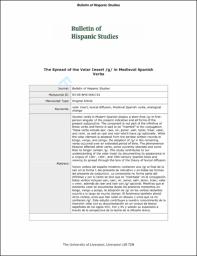| dc.description.abstract | **Please note that the full text is embargoed** ABSTRACT: Several verbs in Modern Spanish display a stem-final /g/ in firstperson singular of the present indicative and all forms of the present subjunctive. The consonant is not part of the infinitive of these verbs and hence is said to be “inserted” in the conjugation. These verbs include asir, caer, oír, poner, salir, tener, traer, valer, and venir, as well as raer and roer which have /g/ optionally. While the velar element is attested from the earliest written records in tengo, vengo, and pongo, the adoption of /g/ in the remaining verbs occurred over an extended period of time. The phenomenon likewise affected other verbs, some currently obsolete and some that no longer contain /g/. This study contributes to our understanding of the velar insert by documenting its appearance in a corpus of 13th-, 14th-, and 15th-century Spanish texts and viewing its spread through the lens of the theory of lexical diffusion.
[Varios verbos del español moderno contienen una /g/ al final de la raíz en la forma 1 del presente de indicativo y en todas las formas del presente de subjuntivo. La consonante no forma parte del infinitivo y por lo tanto se dice que es “insertada” en la conjugación. Estos verbos incluyen asir, caer, oír, poner, salir, tener, traer, valer y venir, además de raer and roer con /g/ opcional. Mientras que el elemento velar se documenta desde los primeros momentos en tengo, vengo y pongo, la adopción de /g/ en los verbos restantes ocurrió a lo largo de mucho tiempo. El fenómeno también afectó otros verbos, unos que han caído en desuso y unos que ya no contienen /g/. Este estudio contribuye a nuestro conocimiento de la inserción velar con su documentación en un corpus de textos españoles de los siglos XIII, XIV y XV y viendo su expansión a través de la perspectiva de la teoría de la difusión léxica.]
[This is an original manuscript / preprint of an article published by Bulletin of Hispanic Studies in Liverpool University Press [University Publisher] in 2011, available online: https://doi.org/10.3828/bhs.2011.1] | en_US |


